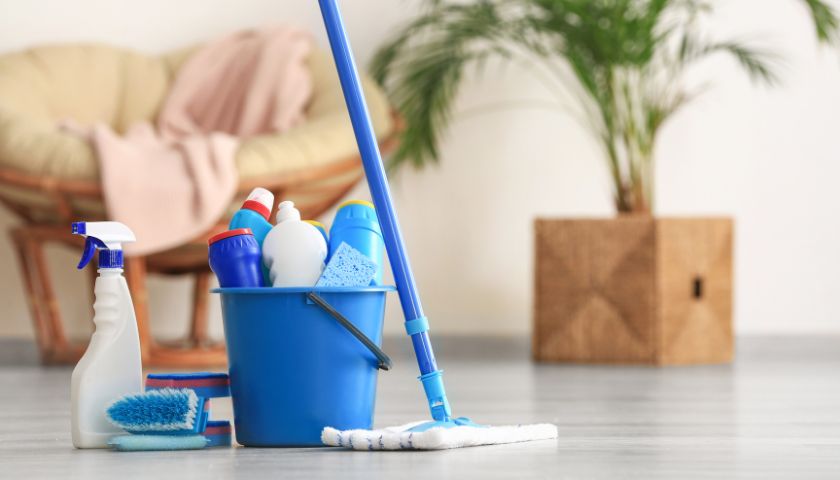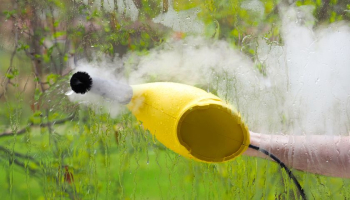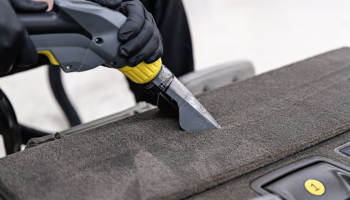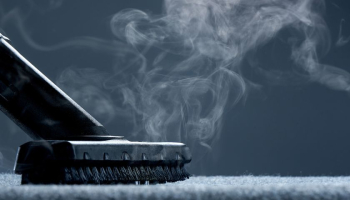How to Mop Floors with Vinegar | Learn Some Efficient Tips

Keeping your floors clean can be a challenging task, especially when you have to deal with stubborn stains and dirt. Vinegar can be a great option if you’re looking for an effective, eco-friendly, and budget-friendly solution to mop your floors.
Vinegar is a versatile and natural cleaning agent that can help you achieve a sparkling and germ-free floor without harmful chemicals. In this guide, I will show you how to mop floors with Vinegar step-by-step.
It will also provide tips and tricks to make the process more efficient and effortless. Whether you’re a busy homeowner or a cleaning enthusiast, mastering mopping with Vinegar can save you time, money, and headaches in the long run.
Contents
Cleaning Linoleum and Porcelain Floors with Vinegar
Cleaning linoleum and porcelain floors with Vinegar is a safe and effective way to remove dirt. It (Vinegar) doesn’t require harsh chemicals since it has cleansing power to fight against grime.
One of the common reasons that anyone should use Vinegar on linoleum and porcelain floors is to clean grouts.
Vinegar is so gentle for cleaning grouts from these hard surfaces. Again, it is optional to dilute the cleanser before cleaning. Herein is the whole process of cleaning these selected surfaces:
Materials
- White Vinegar
- Water
- Bucket
- Mop or cloth
Instructions
- Sweep or vacuum the floor to remove any loose dirt and debris.
- Mix equal white Vinegar and water (50:50) in a bucket. You can use a more significant amount of Vinegar if the floor is dirty.
- Dip a mop or cloth into the solution and wring it out well.
- Begin mopping or wiping the floor, starting at the farthest corner of the room and working toward the door. Ensure to wash the mop or cloth frequently to avoid saturating the bottom.
- For stubborn stains, let the vinegar solution sit on the spot for a few minutes before scrubbing it with a soft-bristled brush or cloth.
- Once you have cleaned the entire floor, rinse the mop or cloth thoroughly and go over the floor. Again, try to use plain water to remove any remained vinegar residue.
- Allow the floor to air dry, or use a clean towel.
Note: Avoid using Vinegar on natural stone floors, as it can etch the surface.
Cleaning Tiles, Ceramics, and Hardwood Floors with Vinegar
Vinegar is indeed a versatile household cleaner that can clean floors effectively. Yet, it is a good cleaner; it can be used on tiles, ceramics, hardwood, and stones. Here’s how you can use Vinegar to clean each of these surfaces:
Tiles And Ceramic
- Mix equal parts of white Vinegar and water in a spray bottle.
- Spray the solution onto the tiles and ceramic surface.
- Let it sit for a few minutes to dissolve any grime or dirt.
- Scrub the surface with a soft brush or sponge.
- Rinse it with water and wipe it dry.
Hardwood
- Gather a quarter cup of white Vinegar and water in a bottle. Make sure to use warm water for this process to attain good outputs.
- Dip a soft mop into the solution and wring it out entirely.
- Mop the hardwood floor, being careful not to saturate it with the solution.
- Rinse the mop using clean, pure water. Up next, take out your regular mopping instrument and start cleaning to remove any residues.
- Dry out the floor with a rag or towel, and it is done.
Stones
- Collect white Vinegar in a container. Make sure to gather an equal portion of water and Vinegar. That means if you put 1 gallon of water into the bottle. Try to add half a bit or a big cup of Vinegar there. After pouring them all together, shake the bottle to mix them well.
- Spray the solution onto the stone surfaces.
- Let it sit for a few minutes to loosen any dirt or grime.
- Scrub the surface with a soft brush or sponge.
- Rinse with water and wipe dry.
Important Note
- Always test the vinegar solution on a small, inconspicuous surface area before using it on the entire site. It will do nothing but help to prevent unpredictable damages.
- Don’t use Vinegar on natural stone surfaces, such as marble or granite. Those surfaces might react badly when coming close to the vinegar mixture.
- Do not use it on waxed or oiled hardwood floors. Otherwise, it can remove the protective finish from there.
- Try to ventilate the area well when using Vinegar, as the fumes can be strong and cause damage to the floor.
What to Do to Reduce the Bad Smell of Vinegar While Cleaning?
Vinegar is a natural cleaner and disinfectant that can effectively clean floors. But its strong odor can sometimes be unpleasant. Here are a few tips to reduce the foul smell of Vinegar while cleaning your floors:
1. Dilute the Vinegar
Mix one part vinegar and three parts water to dilute the solutions. This will help to reduce the strong smell of Vinegar.
2. Add Essential Oils
Add a few drops of essential oils such as lemon, lavender, or peppermint to the vinegar solution. It will help to mask the smell. Essential oils also have natural cleaning properties and can enhance the cleaning power of Vinegar.
3. Open Windows and Doors
Allow fresh air to circulate by opening windows and doors while cleaning. This will work to eliminate the foul smell of Vinegar. All in all, it is valuable to improve the air quality around the house.
4. Use A Fan
Use a fan to help circulate the air and remove the strong smell of Vinegar from the room. Keep wide open the windows or the air exhaust fan as an alternate if it isn’t available to you right now.
5. Use Baking Soda
After cleaning with Vinegar, you can sprinkle some baking soda on the floor. After applying it, leave the mixture many times. Let it sit for a few minutes before vacuuming it. This absorbs the remaining odor and leaves the room smelling fresh.
By using these tips, you can reduce the strong smell of Vinegar. Moreover, it lets you enjoy this versatile ingredient’s natural cleaning power.
Common Mistakes to Avoid While Using Vinegar to Clean a Floor
Here are some common mistakes to avoid when cleaning floors with Vinegar:
1. Using Undiluted Vinegar
Vinegar is highly acidic and can damage certain surfaces, primarily when used in its undiluted form. Therefore, always use dilute Vinegar with water before mopping the floors.
2. Apply on Unsealed Surfaces
Another common mistake is applying Vinegar on unsealed surfaces. Floors that are made with natural stone, unsealed grout, and waxed or oiled can be damaged by Vinegar.
In that case, you must check the manufacturer before using Vinegar on unsealed surfaces.
3. Using Too Much Vinegar
While Vinegar is a natural cleaning agent, too much can leave a residue that attracts dirt. Use only a tiny amount of it in the cleaning solution. Then rinse the floor thoroughly after using it with plenty of water.
4. Mixing Vinegar with Other Cleaning Products
Vinegar should not be mixed with other cleaning products, especially those that contain bleach or ammonia. This can create toxic fumes that are harmful to kids and pets.
5. Not Testing on A Small Area First
Before using Vinegar to clean floors, test it on a small area first. This will help you determine whether it is safe for use on these surfaces.
Otherwise, it will not be good for further steps and can cause dangerous harm to the house floor.
6. Use on Laminate Floor
Vinegar isn’t recommended to use over laminate floors. Vinegar contains acidic properties that can dull the floor’s natural finish. So, in case you use it on the laminate floor, it may damage or spoil forever.
7. Mix Vinegar with Bleach
You shouldn’t use bleach with Vinegar. This combination often produces toxic fumes that aren’t good for the skin and health. People who have susceptible and allergic skin should be conscious of this.
Instead of bleach, always use water with Vinegar to make it safe and eco-friendly.
Frequently Asked Questions (FAQs)
Is It Ok to Mop Floors with Vinegar?
Of course, you can mop the floors with Vinegar. It is a safe, sound ingredient that directly reduces stubborn grime from the floor.
Unlike any hard chemical floor cleaner, it doesn’t damage floor finishes. Instead of damaging it, Vinegar produces a gorgeous, tidy floor.
Does Mopping the Floor with Vinegar Leave Smells?
Mopping the floor with Vinegar indeed gives you excellent results. But sometimes you may not like the solid bad odor produced by it.
Hence, adding some essential oil can prevent bad smells from spreading around the room. Essential oil is valuable in reducing its foul odor.
Can Vinegar Whiten the Tiles Floor?
Vinegar sometimes whitens the tile floor effectively. But you must follow some steps, including making a strong cleansing paste. Use a quarter amount of bicarbonate of soda and water.
Then leave it over the floor and scrub it. After following the step, the last one is to rinse areas with Vinegar. You will notice the result in front of your eyes.
Can I Mop Wood Floor Using Vinegar?
Follow some essential tips to clean and mop wood floors using Vinegar. The first step is to mix ½ cup of Vinegar with 1 gallon of water. Use this solution over the floor thoroughly and then scrub.
Finally, mop it with plain water and leave it for a while for the air to dry.
What Surface Should I Avoid Cleaning with Vinegar?
Floors with hard stones and marbles shouldn’t be cleaned with Vinegar.
Also, avoid using it on granite, marble, stone, and waxed finishes. The acidity of the Vinegar is enough to scratch and degrade these materials.
Before ending this, mopping the floor with Vinegar varies and depends on some perspectives. It should be clarified before starting the job.
One last caution I want to add is to wear proper safety precautions. I know Vinegar is safe, but it could be dangerous and harmful to sensitive people.
However, I hope you get proper guidelines through my writing on how to mop floors with Vinegar. If you’ve any other queries, email me or comment. Lastly, mop the floor with Vinegar and instantly enjoy fresh, clean, hygienic floors.






![How to Attach a Swiffer Wet Pad? [Learn to Do It Correctly]](https://mopsreview.com/wp-content/uploads/thumbs_dir/How-to-Attach-Swiffer-Wet-Pad-20ohih1eaj9c1n0speeheg51u8ulaobz5p513g7q9y90.jpg)

